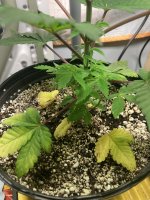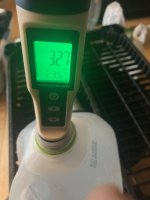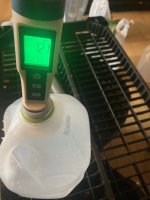I Care
Well-known member
If you have a blend that you wish to calculate your Macro and Micronutrient PPM using teaspoons, the conversion is described in this post.
My desire for this thread is that the firstpage contains a reply about the other ratios that affect the raw calculations I have done here. The multiplications necessary to determine the actual available nutrients for those that are not reflected by raw numbers provided by the manufacturer.
I like everybody here, but I want this first page to be the true wealth of converting any food, for anybody who uses any product anywhere in the world as water soluble nutrients. After the boring stuff is out of the way, the next pages would be great for fun and laughs.
An elemental nutrient at 10% added at 1tsp/Gal comes out to 129ppm per gallon.
The calculations for teaspoons are as follows.
(X): represents the elemental nutrient
X = 10.0 Then 1.0 x 129 = 129ppm per Gallon
Now let’s move to an example of a micro nutrient represented by Y
Y = 0.05 Then 0 .005 x 129 = 6.45ppm per Gallon
Now here is an example of a water soluble nutrient thy can be bought at Home Depot.
NPK 12 - 5 - 7 Vigoro All Season All Purpose on hardware store shelves in the US.
N = 12 1.2 x 129 = 154.8 ppm / N
P = 5 .5 x 129 = 64.5 ppm / P
K = 7 .7 x 129 = 38.7
You will continue with the same reduction
The elemental analasys time .1 multiplied by 129 equals the ppm per gallon.
Here is an example of some micros
Ca = 1 .1 x 129 = 12.9 ppm / Ca
S = .4 .04 x 129 = 5.1 ppm / S
Mg= .2 .02 x 129 = 2.58 ppm/ Mg
Zn= .01 .001x129= .129 ppm/ Zn
Edit — improved EQUATION for rough calculations
Multiply guaranteed analysis directly to 12.9 It makes more sense than moving the decimal place in the g/a % N10 x 12.9 is 129ppm/N
I missed this thinking I was a genius lol
Someone please reply with the clarification for further reduction of these numbers based on available P and K and whatever else. I know there is more to this, determining the actual PPMs that is available from water soluble nutrient percentages listed on the packaging.
Thanks, hope we can create something beneficial.
Props to David O’Connor, the guy on the Scottish throne, for sharing this informantion
My desire for this thread is that the firstpage contains a reply about the other ratios that affect the raw calculations I have done here. The multiplications necessary to determine the actual available nutrients for those that are not reflected by raw numbers provided by the manufacturer.
I like everybody here, but I want this first page to be the true wealth of converting any food, for anybody who uses any product anywhere in the world as water soluble nutrients. After the boring stuff is out of the way, the next pages would be great for fun and laughs.
An elemental nutrient at 10% added at 1tsp/Gal comes out to 129ppm per gallon.
The calculations for teaspoons are as follows.
(X): represents the elemental nutrient
X = 10.0 Then 1.0 x 129 = 129ppm per Gallon
Now let’s move to an example of a micro nutrient represented by Y
Y = 0.05 Then 0 .005 x 129 = 6.45ppm per Gallon
Now here is an example of a water soluble nutrient thy can be bought at Home Depot.
NPK 12 - 5 - 7 Vigoro All Season All Purpose on hardware store shelves in the US.
N = 12 1.2 x 129 = 154.8 ppm / N
P = 5 .5 x 129 = 64.5 ppm / P
K = 7 .7 x 129 = 38.7
You will continue with the same reduction
The elemental analasys time .1 multiplied by 129 equals the ppm per gallon.
Here is an example of some micros
Ca = 1 .1 x 129 = 12.9 ppm / Ca
S = .4 .04 x 129 = 5.1 ppm / S
Mg= .2 .02 x 129 = 2.58 ppm/ Mg
Zn= .01 .001x129= .129 ppm/ Zn
Edit — improved EQUATION for rough calculations
Multiply guaranteed analysis directly to 12.9 It makes more sense than moving the decimal place in the g/a % N10 x 12.9 is 129ppm/N
I missed this thinking I was a genius lol
Someone please reply with the clarification for further reduction of these numbers based on available P and K and whatever else. I know there is more to this, determining the actual PPMs that is available from water soluble nutrient percentages listed on the packaging.
Thanks, hope we can create something beneficial.
Props to David O’Connor, the guy on the Scottish throne, for sharing this informantion
Attachments
Last edited:






